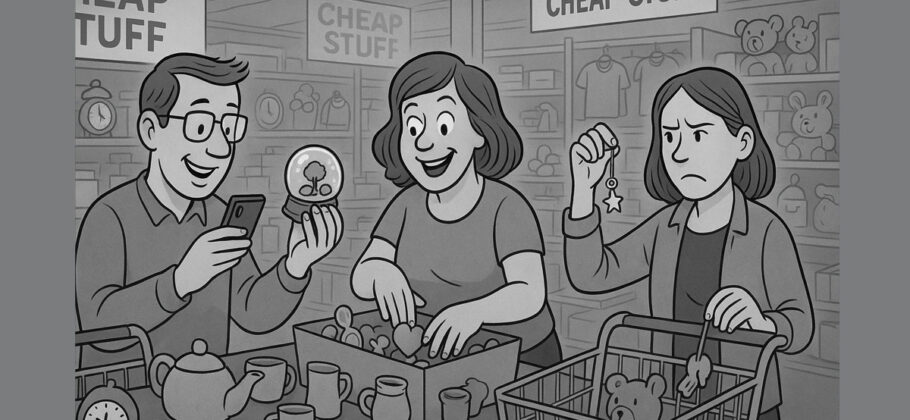America has many traditions. Apple pie. Football on Thanksgiving. And apparently buying capri pants for less than the price of a burger and fries. As one shopper, Kay Washburn, proved when she clicked “purchase” on a pair for $5.95, cheap goods have become so normal that we hardly blink. For decades, Americans have been turning from makers of stuff into buyers of it. Prices have been so low, and shipping so fast, that we have become hooked on the thrill of getting something new with almost no effort. Unfortunately, like all habits built on convenience and impulse, this one comes with consequences.
How Deep Is the Addiction
Many Americans barely pause before buying clothing, toys, housewares or home décor that will be worn or used only a few times. People now wear an article of clothing only seven times before tossing or donating it. In 2024 alone, American households made an average of 110 home and garden purchases, up from 95 just five years earlier. We averaged 38 toy purchases, 19 women’s clothing purchases, and more than a few poorly fitting vacation outfits ordered from places like Shein. Some consumers, like Kanwal Haq, bought so much that they started racing their spouses to the mailroom just to hide the evidence.
The examples are endless, but the most common ones include:
• fast fashion clothes worn for a season
• flimsy home décor items that break by the time you open the box
• influencer inspired beauty products that cause breakouts
• endless multipacks of cheap accessories like watch bands
• holiday gifts still sitting in bags years later
• bargain flatware and dishes that pile up faster than we can store them
These items feel harmless one by one. But they add up, and the real clutter problem is now so large that the Wall Street Journal reports heirs are overwhelmed by the time it takes to clean out family homes. We are literally burying ourselves under our own bargains.
Why This Is Becoming a Problem
The cost of cheap stuff goes far beyond the price tag. It has environmental impacts, fills landfills, strains storage in our homes, and pushes families toward quantity instead of quality. People buy furniture, clothing, and household goods that are so cheap they do not justify the cost of repairing them. Instead of valuing long lasting items, we value the dopamine hit of clicking buy.
Psychologists say the brain rewards short term pleasure over long term goals. Every new purchase brings a burst of excitement that fades almost immediately. Then the cycle restarts, helped along by marketing emails, social media, and the feeling that everyone else is buying something too. One anthropologist noted that changing this pattern would take a shift as deep as the one caused by the Great Depression.
Even self identified declutterers are drowning. One former supply chain manager discovered untouched moving boxes from eight years ago, Christmas gifts still in their bags, and over 100 free T shirts. She admits her stress cleaning is now as much emotional coping as it is practical housekeeping.
How Trade Negotiations Are Interrupting the Habit
President Trump’s tariff policies have started to interfere with America’s relationship with cheap imports, especially from Asia. The average effective tariff has climbed from 2.5 percent to 13 percent, with some categories of goods affected far more. The administration closed loopholes that once allowed ultracheap products to enter tariff free. Even after recent negotiations with China lowered the highest spring rates, many goods still face average tariffs of about 48 percent.
Trump has suggested that Americans might simply buy less. He even joked that children could be content with two dolls instead of 30. That comment landed somewhere between old fashioned thrift and a parent quietly wishing their house was not overflowing with plastic toys.
Corporations know consumers will not accept unlimited price increases. Many companies have held back from passing tariffs on to shoppers, but few believe this will last. Inflation is already ticking up, and voters are newly agitated about affordability. Economists say prices will eventually rise, and that could force Americans to rethink how much stuff they buy.
Some people are already experimenting with new habits. Influencer Ava Vancour noticed a sharp drop in views on her back to school shopping hauls. People may be hesitating to buy even when prices remain low. She has shifted to videos that show her reusing items she already owns and joining Project Pan, where she finishes a makeup product before buying another one. Meanwhile, older shoppers like Washburn are trying meditation apps whenever they feel the urge to scroll Temu.
What the Future Could Look Like
Tariffs may cause Americans to buy less in the short term. Some say people might discover that high quality items, secondhand goods or local artisan products feel better than five dollar pants that barely survive a wash cycle. Others believe the addiction is so strong that as soon as prices ease people will rush back to their old habits. After all, the pandemic showed that even temporary supply chain shocks could not stop long term demand.
Whether tariffs truly break America’s addiction to cheap stuff remains to be seen. But for now, this period of rising prices offers a chance for consumers to rethink what they buy, how much they buy and why they buy it. And who knows, maybe simplifying our closets and cutting back on compulsive shopping will turn out to be good for both the country and our bulging dresser drawers.
One thing is certain. Kay Washburn was right when she said that we need a happy medium. Something between her 1950s dream dress that took 50 hours of babysitting and the disposable capri pants she wears for just a season. Maybe, with prices climbing and trade tensions rising, that medium finally has a chance to return.





